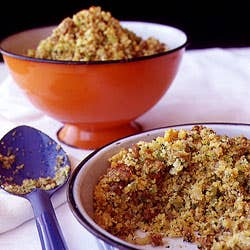
Inside Story
The real point of holiday feasting isn’t turkey at all; it’s the stuffing in the bird.
Let's be honest about this: You know and I know, and I know that you know, that the only reason people still bother to make a big deal out of Thanksgiving dinner these days is the stuffing. I mean, come on, now. Does cranberry sauce really make your little heart go pitty-pat? Would you mope and mourn if you found out tomorrow that you were allergic to pumpkin? If you really like yams all that much, how come you eat them only once a year?
And as for turkey…it's fine, I guess, if you like that sort of thing, but you hardly have to wait until the third Thursday in November to enjoy it. It has become a quotidian experience. We're all but surrounded by this fan-tailed bird or, at least, by its processed parts— turkey bacon, turkey franks, turkey sausage, turkey burgers (a really bad idea). The deli downstairs from our office has a whole roast turkey on the steam table a couple of times a week, even in midsummer. Harry's Bar in Venice now serves tacchino (turkey) instead of vitello (veal) tonnato.
But stuffing…stuffing is, well, the stuff of Thanksgiving, the core, the heart, the thing that grounds it, holds it all together, turns it from a mere big meal into a celebratory abundance. You can have seconds of anything at Thanksgiving dinner, but stuffing is the thing that keeps you coming back for more.
Theoretically, you can eat stuffing (also known as "dressing", a term apparently inspired by Victorian modesty) on other occasions, of course. You might be able to find (or reconstruct) one of those little "stuffing pies"—basically, potpie shells filled with stuffing—I once saw in a bakery in Atlanta; you might be able to rustle up some wan imitation of Thanksgiving stuffing for your rolled pork loin or your Sunday-dinner game hens. You might even hie yourself down to the supermarket and, when you're sure nobody's looking, grab a box or two of Stove Top stuffing—introduced by General Foods back in 1973—from the shelf next to the Hamburger Helper. But that would be sort of like eating maraschino cherries right out of the jar instead of plucking them from your manhattan (or your shirley temple) the way civilized people do. That would be eating out of context.
The whole idea of stuffing things—not just fowl but almost any kind of beast or vegetable (the Romans stuffed dormice)—seems to have evolved out of two parallel but antithetical urges: that of conspicuous gastronomy (the roast pig packed with sausages and blood pudding at Trimalchio's feast; the turkeys filled with pigeons and brains served by a show-off Spanish diplomat in 1638) and that for sheer survival (the scrawny chicken or watery zucchini doubled in bulk by the insertion of old dry bread, wild-growing herbs, and miscellaneous table scraps, all mushed up together).
Today in America, the motivating factor behind our stuffings seems to be neither gastronomy nor survival but good, old-fashioned, uncomplicated indulgence. We tend to stuff our holiday turkey (or goose, if you insist) primarily with bread or corn bread, commonly enhanced with onions and celery, frequently scented with dried sage, and usually customized according to taste, geography, and/or ethnic heritage. The addition of giblets to the mix, for instance, echoes medieval English stuffing recipes based on pig liver; rice and pecans show up frequently in stuffings from the South, as, naturally, does corn bread; Texans have been known to spice up their stuffings with jalapeños; oysters, once very cheap in America, might be included in the East and the Pacific Northwest; citizens of Teutonic descent tend to favor apples and dried fruits; Italian-Americans (and other sensible people) add sausage to the recipe; and more than one Chinese-American family we've heard about sneaks wood ear mushrooms in there someplace.
We're not the only nation that stuffs turkey. In 18th-century France, for instance, turkey bursting with black truffles was all the rage for a time, although the preparation was so expensive (the bird is said to have cost nearly as much as the tubers) that, as M.F.K. Fisher once put it, "[o]nly the courtesans and the great lords could afford the dish." Today, Parisian chef Guy Savoy makes his own version of a Thanksgiving Turkey with a sophisticated stuffing of bresse chicken forcemeat larded with foie gras.
The French word for stuffing, you might be interested to learn, is farce, and there is apparently an etymological connection between buffet and buffoonery._ Farce_ in a culinary sense, first used in English in 1430 (as in "farse the catte within als thu farses a gos", which, incidentally, I've always found to be good advice), derives from the Latin verb farcire, meaning, er, "to stuff". The Oxford English Dictionary finds uses of farce to mean something comical as early as 1530 and theorizes that this meaning developed from the humorous interpolations that actors made between serious declamations in religious plays—thereby padding out, or "stuffing", the texts.
Etymology aside, however, I would frankly not advise greeting the serving of stuffing at your Thanksgiving dinner this year with the phrase "What a farce!" You might end up next year with nothing but yams.
Keep Reading
Continue to Next Story










